Chermebilaenes A and B, New Bioactive Meroterpenoids from Co-Cultures of Marine-Derived Isolates of Penicillium bilaiae MA-267 and Penicillium chermesinum EN-480
Abstract
1. Introduction
2. Results and Discussion
2.1. Structure Elucidation of the New Compounds
2.2. Biological Activities of the Isolated Compounds
3. Materials and Methods
3.1. General
3.2. Fungal Material
3.3. Fermentation
3.4. Extraction and Isolation
3.5. Hydrolysis of Compound 1
3.6. Antimicrobial Assay
4. Conclusions
Supplementary Materials
Author Contributions
Funding
Acknowledgments
Conflicts of Interest
References
- Carroll, A.R.; Copp, B.R.; Davis, R.A.; Keyzers, R.A.; Prinsep, M.R. Marine natural products. Nat. Prod. Rep. 2020, 37, 175–223. [Google Scholar] [CrossRef] [PubMed]
- Imhoff, J.F. Natural products from marine fungi—Still an underrepresented resource. Mar. Drugs 2016, 14, 19. [Google Scholar] [CrossRef] [PubMed]
- Barzkar, N.; Tamadoni, J.S.; Poorsaheli, H.B.; Vianello, F. Metabolites from marine microorganisms, micro, and macroalgae: Immense scope for pharmacology. Mar. Drugs 2019, 17, 464. [Google Scholar] [CrossRef] [PubMed]
- Gross, H. Genomic mining—A concept for the discovery of new bioactive natural products. Curr. Opin. Drug Discov. Dev. 2009, 12, 207–219. [Google Scholar] [CrossRef]
- Scherlach, K.; Hertweck, C. Triggering cryptic natural products biosynthesis in microorganisms. Org. Biomol. Chem. 2009, 7, 1753–1760. [Google Scholar] [CrossRef] [PubMed]
- Ueda, K.; Beppu, T. Antibiotics in microbial coculture. J. Antibiot. 2017, 70, 361–365. [Google Scholar] [CrossRef] [PubMed]
- Marmann, A.; Aly, A.H.; Lin, W.; Wang, B.; Proksch, P. Co-Cultivation—A powerful emerging tool for enhancing the chemical diversity of microorganisms. Mar. Drugs 2014, 12, 1043. [Google Scholar] [CrossRef] [PubMed]
- Meng, L.H.; Liu, Y.; Li, X.M.; Xu, G.M.; Ji, N.Y.; Wang, B.G. Citrifelins A and B, citrinin adducts with a tetracyclic framework from cocultures of marine-derived isolates of Penicillium citrinum and Beauveria felina. J. Nat. Prod. 2015, 78, 2301–2305. [Google Scholar] [CrossRef] [PubMed]
- Meng, L.H.; Li, X.M.; Liu, Y.; Wang, B.G. Penicibilaenes A and B, sesquiterpenes with a tricyclo[6.3.1.01,5]dodecane skeleton from the marine isolate of Penicillium bilaiae MA-267. Org. Lett. 2014, 16, 6052–6055. [Google Scholar] [CrossRef] [PubMed]
- Liu, H.; Li, X.M.; Liu, Y.; Zhang, P.; Wang, J.N.; Wang, B.G. Chermesins A–D: Meroterpenoids with a drimane-type spirosesquiterpene skeleton from the marine algal-derived endophytic fungus Penicillium chermesinum EN-480. J. Nat. Prod. 2016, 79, 806–811. [Google Scholar] [CrossRef] [PubMed]
- Hu, X.Y.; Li, X.M.; Yang, S.Q.; Liu, H.; Meng, L.H.; Wang, B.G. Three new sesquiterpenoids from the algal-derived fungus Penicillium chermesinum EN-480. Mar. Drugs 2020, 18, 194. [Google Scholar] [CrossRef] [PubMed]
- Lee, J.H.; Lee, K.R. Phytochemical constituents of Cirsium nipponicum (MAX.) Makino. Kor. J. Pharmacogn. 2005, 36, 145–150. [Google Scholar]
- Liu, Y.; Li, X.M.; Meng, L.H.; Jiang, W.L.; Xu, G.M.; Huang, C.G.; Wang, B.G. Bisthiodiketopiperazines and acorane sesquiterpenes produced by the marine-derived fungus Penicillium adametzioides AS-53 on different culture media. J. Nat. Prod. 2015, 78, 1294–1299. [Google Scholar] [CrossRef] [PubMed]
- Ishikawa, K.; Sato, F.; Itabashi, T.; Wachi, H.; Takeda, H.; Wakana, D.; Yaguchi, T.; Kawai, K.; Hosoe, T. Asnovolins A-G, spiromeroterpenoids isolated from the fungus Aspergillus novofumigatus, and suppression of fibronectin expression by asnovolin E. J. Nat. Prod. 2016, 79, 2167–2174. [Google Scholar] [CrossRef] [PubMed]
- Frisch, M.J.; Trucks, G.W.; Schlegel, H.B.; Scuseria, G.E.; Robb, M.A.; Cheeseman, J.R.; Scalmani, G.; Barone, V.; Mennucci, B.; Petersson, G.A.; et al. Gaussian 09, Revision D.01; Gaussian, Inc.: Wallingford, CT, USA, 2013. [Google Scholar]
- Zhang, G.J.; Li, Y.H.; Jiang, J.D.; Yu, S.S.; Wang, X.J.; Zhuang, P.Y.; Zhang, Y.; Qu, J.; Ma, S.G.; Li, Y.; et al. Diterpenes and sesquiterpenes with anti-coxsackie virus B3 activity from the stems of Illicium jiadifengpi. Tetrahedron 2014, 70, 4494–4499. [Google Scholar] [CrossRef]
- Yue, Q.; Miller, C.J.; White, J.F., Jr.; Richardson, M.D. Isolation and characterization of fungal inhibitors from Epichloë festucae. J. Agric. Food Chem. 2000, 48, 4687–4692. [Google Scholar] [CrossRef] [PubMed]
- Granica, S.; Lohwasser, U.; Jöhrer, K.; Zidorn, C. Qualitative and quantitative analyses of secondary metabolites in aerial and subaerial of Scorzonera hispanica L. (black salsify). Food Chem. 2015, 173, 321–331. [Google Scholar] [CrossRef] [PubMed]
- Pierce, C.G.; Uppuluri, P.; Tristan, A.R.; Wormley, F.L., Jr.; Mowat, E.; Ramage, G.; Lopez-Ribot, J.L. A simple and reproducible 96-well plate-based method for the formation of fungal biofilms and its application to antifungal susceptibility testing. Nat. Protoc. 2008, 3, 1494–1500. [Google Scholar] [CrossRef] [PubMed]
- Watanabe, T.; Yamamoto, Y.; Miura, M.; Konno, H.; Yano, S.; Nonomura, Y. Systematic analysis of selective bactericidal activity of fatty acids against Staphylococcus aureus with minimum inhibitory concentration and minimum bactericidal concentration. J. Oleo Sci. 2019, 68, 291–296. [Google Scholar] [CrossRef] [PubMed]
- Wang, S.; Li, X.M.; Teuscher, F.; Li, D.L.; Diesel, A.; Ebel, R.; Proksch, P.; Wang, B.G. Chaetopyranin, a benzaldehyde derivative, and other related metabolites from Chaetomium globosum, an endophytic fungus derived from the marine red alga Polysiphonia urceolata. J. Nat. Prod. 2006, 69, 1622–1625. [Google Scholar] [CrossRef] [PubMed]
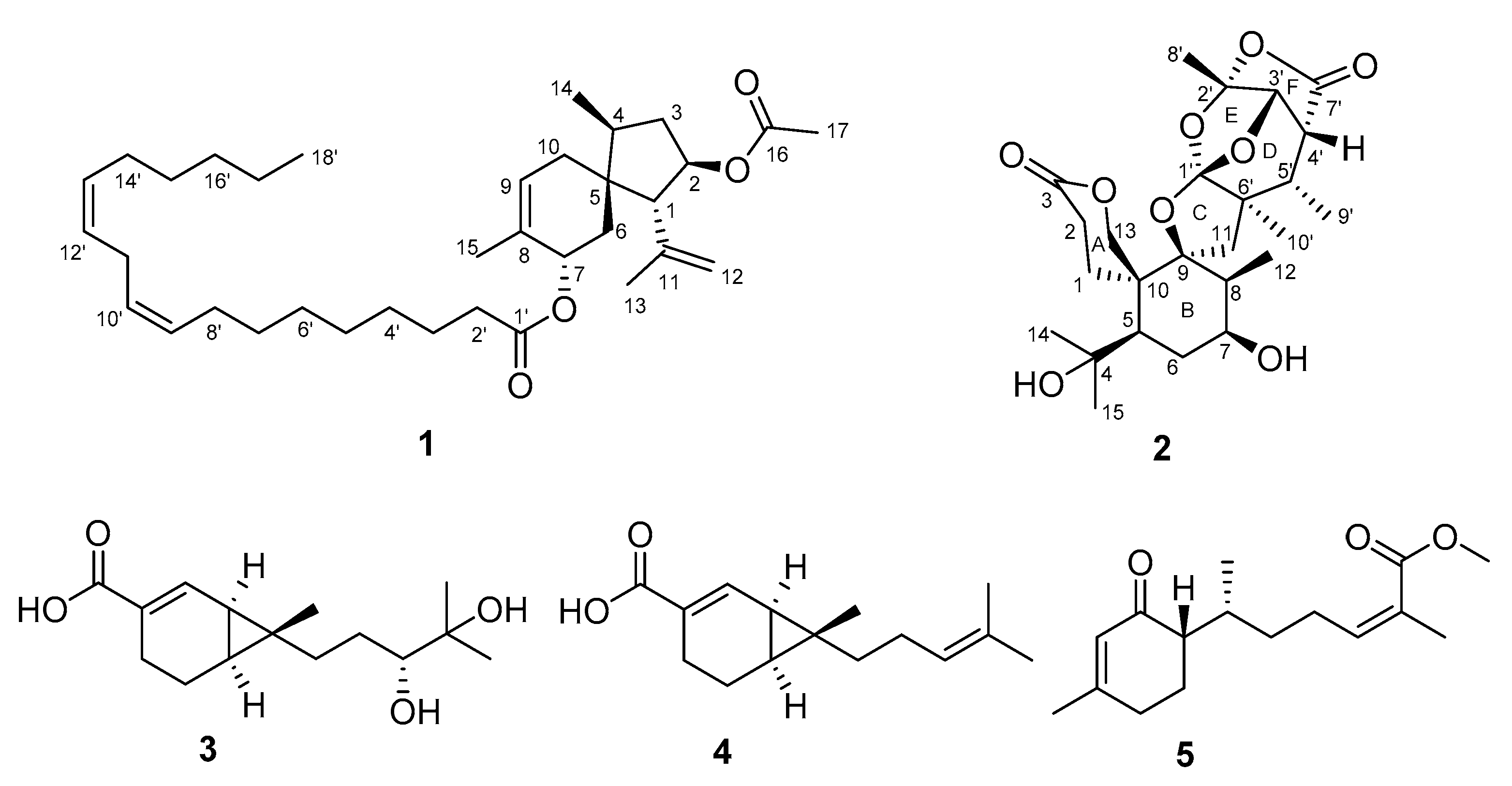
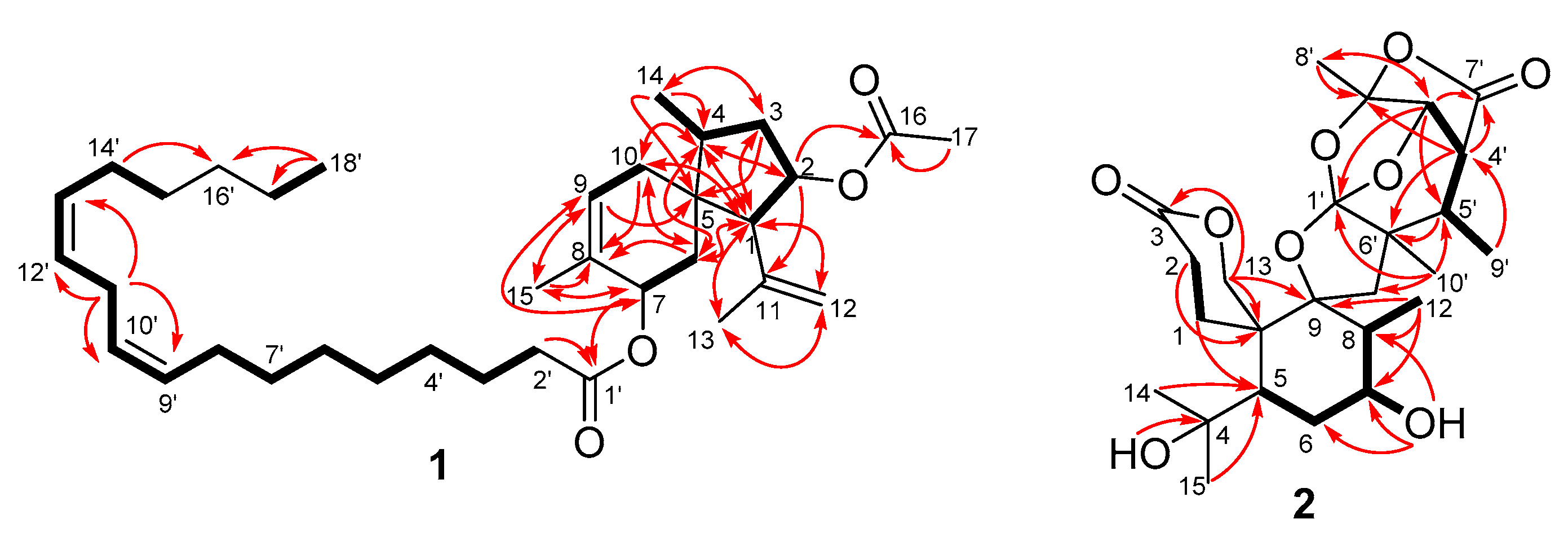
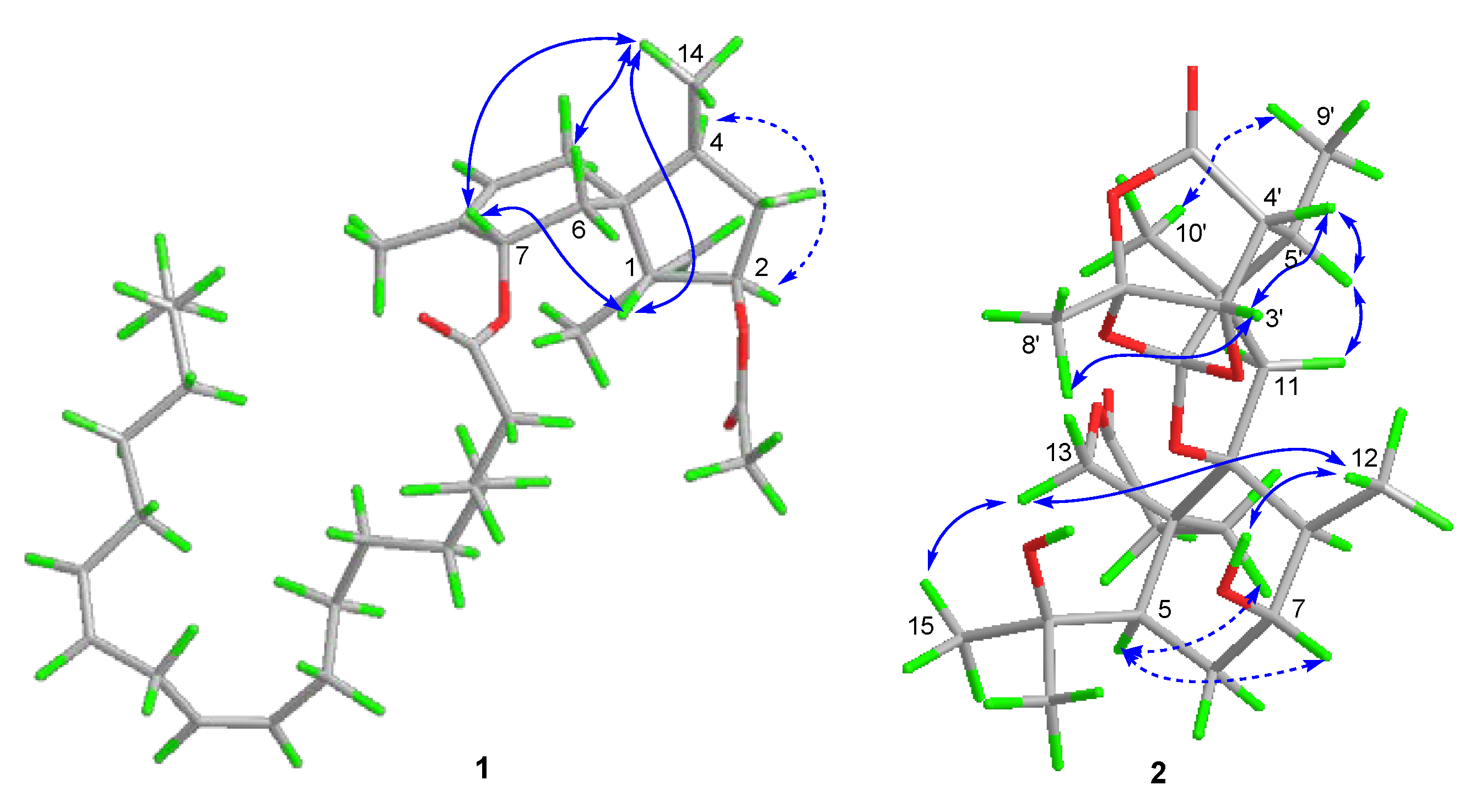
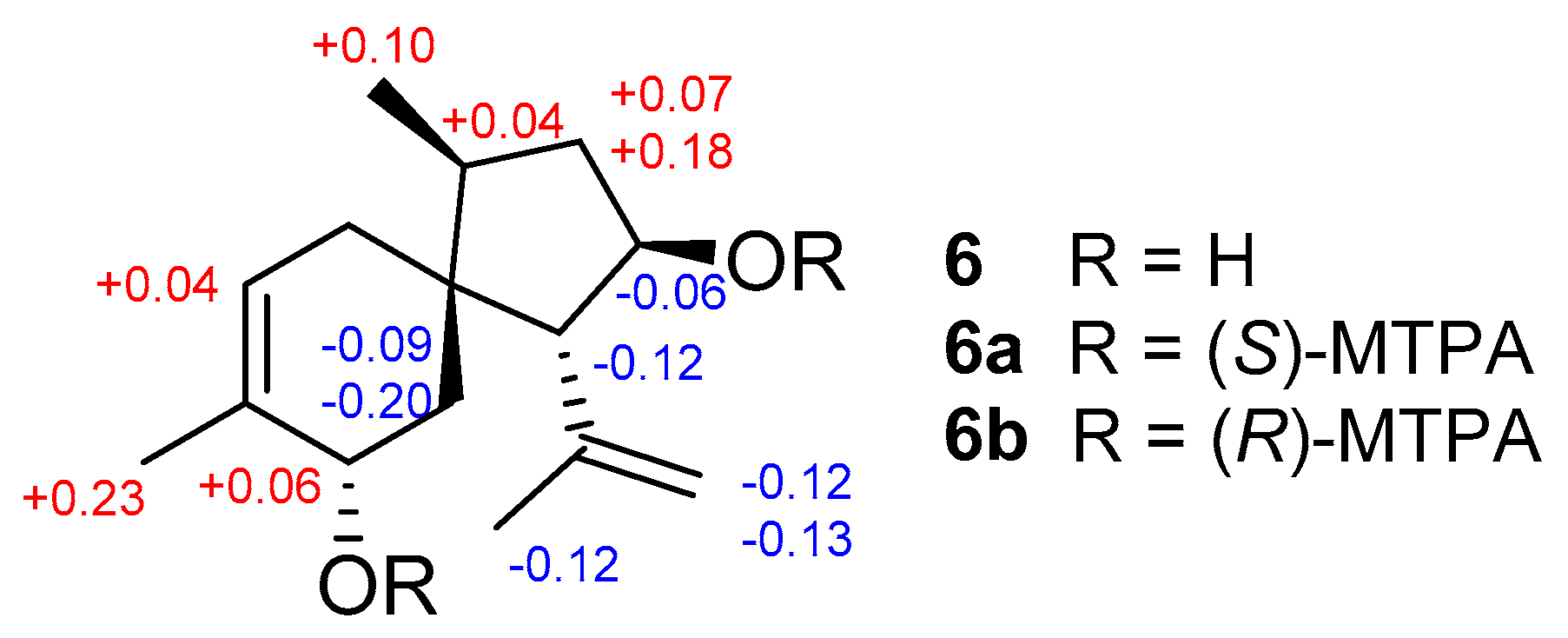
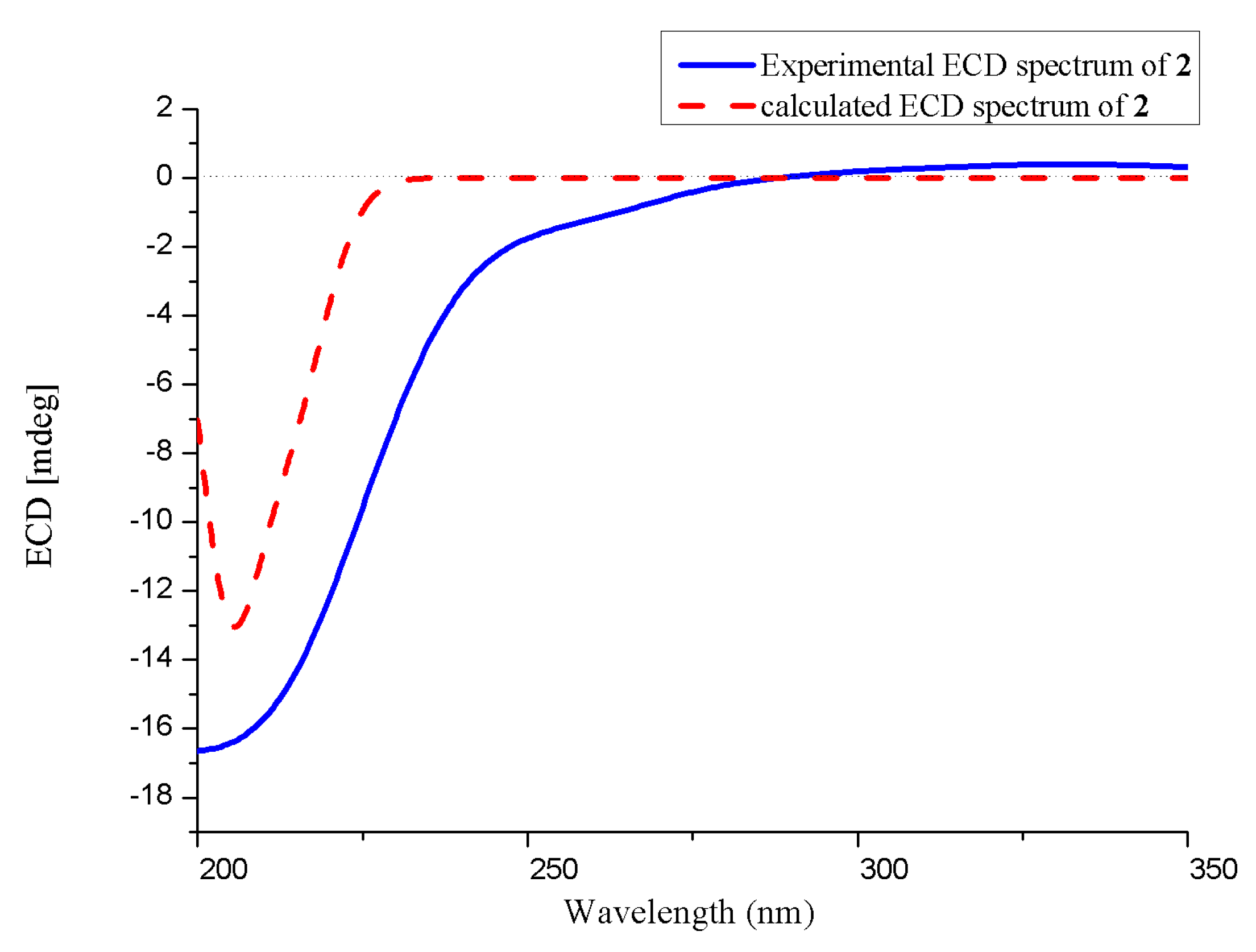
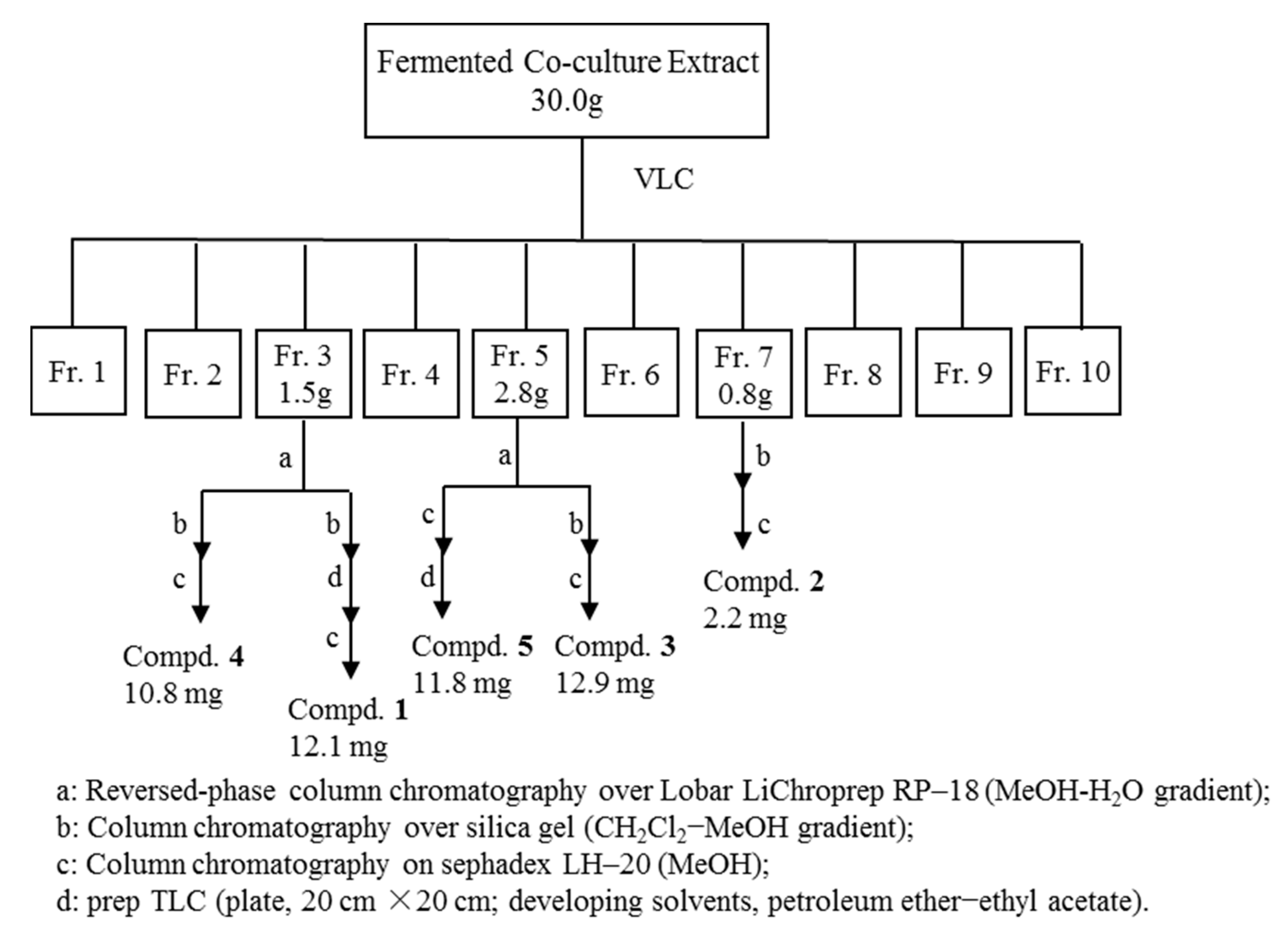
| No. | 1 (Acquired in CDCl3) | 2 (Acquired in DMSO-d6) | ||
|---|---|---|---|---|
| δH (J in Hz) | δC | δH (J in Hz) | δC | |
| 1 | 2.74, overlap | 57.4, CH | α 1.82, ddd (12.7, 9.6, 3.5) β 2.71, ddd (12.7, 10.3, 6.3) | 25.8, CH2 |
| 2 | 5.21, td (8.6, 4.2) | 77.8, CH | 2.33, m | 29.3, CH2 |
| 3 | α 2.53, dt (14.7, 8.6) β 2.02, overlap | 38.7, CH2 | 173.2, C | |
| 4 | 2.02, overlap | 38.3, CH | 73.0, C | |
| 5 | 46.9, C | 1.33, dd (12.6, 2.3) | 49.0, CH | |
| 6 | α 1.66, overlap β 2.02, overlap | 31.9, CH2 | 1.44, m | 29.1, CH2 |
| 7 | 5.38, m | 71.3, CH | 3.71, dq (10.0, 4.0) | 67.0, CH |
| 8 | 132.1, C | 2.39, m | 46.6, CH | |
| 9 | 5.49, dd (3.3, 1.8) | 125.3, CH | 92.1, C | |
| 10 | α 1.70, dd (13.1, 3.3) β 1.98, dd (13.1, 1.8) | 34.8, CH2 | 44.7, C | |
| 11 | 142.8, C | α 2.04, d (13.9) β 1.93, d (13.9) | 49.7, CH2 | |
| 12 | Z 4.69, s E 4.98, brs | 114.4, CH2 | 0.90, d (7.2) | 10.2, CH3 |
| 13 | 1.76, s | 24.4, CH3 | α 4.47, d (12.2) β 4.27, d (12.2) | 66.7, CH2 |
| 14 | 1.08, d (7.1) | 17.6, CH3 | 1.20, s | 34.3, CH3 |
| 15 | 1.63, s | 19.2, CH3 | 1.15, s | 25.9, CH3 |
| 16 | 171.0, C | |||
| 17 | 2.00, s | 21.4, CH3 | ||
| 1’ | 173.8, C | 128.0, C | ||
| 2’ | 2.32, t (7.4) | 31.7, CH2 | 107.2, C | |
| 3’ | 1.66, overlap | 22.9, CH2 | 5.03, d (8.5) | 77.5, CH |
| 4’ | 1.31, overlap | 25.8, CH2 | 2.82, dd (8.5, 6.1) | 41.3, CH |
| 5’ | 1.31, overlap | 27.4, CH2 | 2.05, m | 40.1, CH |
| 6’ | 1.31, overlap | 29.3, CH2 | 46.9, C | |
| 7’ | 1.31, overlap | 29.4, CH2 | 175.3, C | |
| 8’ | 2.05, overlap | 31.5, CH2 | 1.64, s | 22.0, CH3 |
| 9’ | 5.40, dd (10.9, 5.5) | 130.4, CH | 1.06, d (7.2) | 11.7, CH3 |
| 10’ | 5.34, dd (10.9, 6.5) | 128.2, CH | 0.88, s | 18.6, CH3 |
| 11’ | 2.74, overlap | 29.8, CH2 | ||
| 12’ | 5.34, dt (10.9, 6.5) | 128.1, CH | ||
| 13’ | 5.40, dd (10.9, 5.5) | 130.2, CH | ||
| 14’ | 2.05, overlap | 29.5, CH2 | ||
| 15’ | 1.31, overlap | 29.3, CH2 | ||
| 16’ | 1.31, overlap | 25.2, CH2 | ||
| 17’ | 1.31, overlap | 22.7, CH2 | ||
| 18’ | 0.89, t (6.8) | 14.0, CH3 | ||
| 4-OH | 4.36, s | |||
| 7-OH | 4.54, d (4.0) | |||
| Strains | Compounds | |||
|---|---|---|---|---|
| 1 | 2–6 | 7 | Positive Control | |
| A. hydrophiliab | – | – | 4.0 | 0.5 |
| E. tardab | 0.25 | – | 1.0 | 0.25 |
| V. anguillarumb | – | – | 8.0 | 0.5 |
| V. harveyib | – | – | 4.0 | 2.0 |
| V. parahemolyticusb | – | – | 4.0 | 1.0 |
| C. cornigerumc | 0.5 | – | 8.0 | 0.5 |
© 2020 by the authors. Licensee MDPI, Basel, Switzerland. This article is an open access article distributed under the terms and conditions of the Creative Commons Attribution (CC BY) license (http://creativecommons.org/licenses/by/4.0/).
Share and Cite
Meng, L.-H.; Li, X.-M.; Li, H.-L.; Wang, B.-G. Chermebilaenes A and B, New Bioactive Meroterpenoids from Co-Cultures of Marine-Derived Isolates of Penicillium bilaiae MA-267 and Penicillium chermesinum EN-480. Mar. Drugs 2020, 18, 339. https://doi.org/10.3390/md18070339
Meng L-H, Li X-M, Li H-L, Wang B-G. Chermebilaenes A and B, New Bioactive Meroterpenoids from Co-Cultures of Marine-Derived Isolates of Penicillium bilaiae MA-267 and Penicillium chermesinum EN-480. Marine Drugs. 2020; 18(7):339. https://doi.org/10.3390/md18070339
Chicago/Turabian StyleMeng, Ling-Hong, Xiao-Ming Li, Hong-Lei Li, and Bin-Gui Wang. 2020. "Chermebilaenes A and B, New Bioactive Meroterpenoids from Co-Cultures of Marine-Derived Isolates of Penicillium bilaiae MA-267 and Penicillium chermesinum EN-480" Marine Drugs 18, no. 7: 339. https://doi.org/10.3390/md18070339
APA StyleMeng, L.-H., Li, X.-M., Li, H.-L., & Wang, B.-G. (2020). Chermebilaenes A and B, New Bioactive Meroterpenoids from Co-Cultures of Marine-Derived Isolates of Penicillium bilaiae MA-267 and Penicillium chermesinum EN-480. Marine Drugs, 18(7), 339. https://doi.org/10.3390/md18070339






